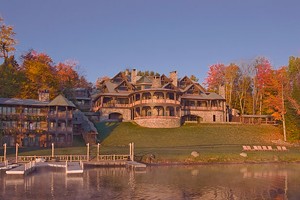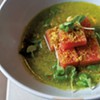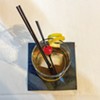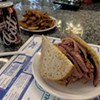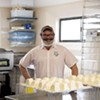Published July 29, 2009 at 4:29 a.m.
The town of Lake Placid is packed with touristy shops, most of them nostalgically touting the 1980 Olympic Games on T-shirts and shot glasses. Its restaurants serve crowds of tired bikers and runners. But if you’ve got the green, a truly placid reality awaits just five minutes from town.
There, after a drive that winds through old forest and past fancy vacation homes, travelers can find the Lake Placid Lodge. Originally built in 1882 as a fishing camp and family getaway with a view of Whiteface Mountain, the building was converted into a hotel in 1946. In late 2005, a devastating fire destroyed much of the main lodge, including numerous paintings and a valuable collection of wine. Today, the property contains 13 suites in the rebuilt lodge, plus 17 cabins that also serve as guest quarters.
But, after a two-hour trip by car and ferry, I’m not here to stay in one of these lodgings that run from $400 to a whopping $1450 per night. I’ve arrived, with my husband in tow, to check out the lodge’s restaurant, Artisans.
Why travel all the way to Lake Placid for dinner? For one thing, the lodge is a member of the international Relais & Châteaux network of inns and hotels, which denotes food and lodgings of the highest quality. And, while the restaurant is too new to have scored scads of press — it opened just last October — it received an enticing preopening write-up in Gourmet. Since the menu is seasonal, none of what writer Nanette Maxim tried then is available now, but her descriptions make it clear the food warrants a visit. She calls chef Kevin McCarthy’s pea soup “mind-blowingly fresh” and waxes eloquent about a plate of rabbit: “It’s a delicate yet masculine dish, full-bodied where it needs to be and with the high notes of the season.”
Despite its Adirondack location, the Lake Placid Lodge has Vermont ties. The Garrett Hotel Group, which owns the inn and three other upscale properties, is headquartered in Burlington. Post-fire, local architecture firm Truex Cullins was hired for the redesign. And guests whiling away time on a rainy day may discover the lodge’s collection of handcrafted wooden jigsaw puzzles from Norwich’s Stave Puzzles, a proud supplier of “teasers,” “tricks” and “traditional” puzzles to chi-chi clientele such as the Gateses and the Clintons.
Those pricey jigsaw puzzles, which are laboriously cut by hand, fit easily into the lodge’s ambiance. The way General Manager John Graham tells it, during the rebuild, the Garretts opted against purely Adirondack décor in favor of Arts and Crafts style. The early-20th-century movement was a reaction against perfect, soulless, industrially produced goods; its aesthetic embraces human craftsmanship with all its imperfections. The dual concepts of “soul and workmanship … fit with the style of service we want to convey,” Graham explains.
You’d never know it from the main entrance, located on a side of the building that’s shingled in unassuming brown cedar. Graham notes that the 30,000-square-foot inn is designed to “wow” guests in a series of “reveals” that turn up as they wander through the property.
It doesn’t take long to impress me. The foyer is decorated with intricately twined branches evoking the primeval forest. From the Map Room — where staffers assist guests in planning hiking or biking routes — there’s a glorious view of the lake and the mountains. The wine cellar, valued at around a million dollars, boasts 800 labels. Graham notes that the collection is now nearly as good as it was before the fire.
But, along with the collection of valuable paintings by artists of the Hudson River School and the gorgeous handmade beds in the guest rooms, there are little touches of whimsy. A mural in the Map Room depicts rhinos wandering a nearby island and fake geographic features named for staffers. In Maggie’s Pub, there’s a stuffed dog that looks much like the bar’s namesake — Graham’s ever-present golden retriever — as well as pillows with leopard spots. A wooden animal head over one fireplace has been nicknamed “the vegan moose.”
“From a guest perspective, it’s truly residential. Behind the scenes, it’s completely commercial, with all of the intelligent technology we could have that made sense,” Graham says of the lodge. He notes that the building’s temperature and sound systems are managed by computer. In the wine cellar, which can be rented for special occasions, patrons can create their own musical playlists.
The smooth rule of technology is especially evident in the kitchen, which proves to be one of the calmest I’ve seen even a mere hour before dinner service. The pastry chef watches our passage from a separate, humidity-and-temperature-controlled area. In the middle of the perfectly clean room is what Graham refers to as a “European-style cooking island,” complete with reach-in coolers filled with ingredients and drawers holding warmed plates. The setup allows chefs to prepare their dishes without stepping away from their stations.
As we pass, a white-clad chef strips the skin from tomatoes with a vegetable peeler. Head chef Kevin McCarthy, although pleasant, doesn’t have time to chat: He’s cleaning the foie gras.
We’re lucky enough to sample slices of the fattened liver during dinner. Seared crisp on the outside but oozing inside, it’s served on a bed of wilted romaine lettuce and toasted slivered almonds, dotted with a few peeled grapes.
After explaining the inn’s story and showing me around, Graham returns to work, and I play at being a guest. I put together part of a puzzle depicting geisha in a gazebo, wander through the common areas taking photos, and finally join my husband on the deck to read, a couple of pricey iced teas from Maggie’s Pub in hand.
When dinnertime rolls around — the inn doesn’t start service until 6 p.m. — we pull ourselves clumsily out of the red-lacquered Adirondack chairs and climb the stairs to Artisans restaurant. The room is surprisingly small; we pass a single party sitting inside. As Graham has explained earlier, patrons of the old lodge were so keen on al fresco dining that the bulk of the inn’s new dining room is located on a curved deck overlooking the lake. In summer and fall, almost everybody eats outside. In winter, when there are fewer guests, the compact interior makes the place feel cozy.
With the sun low in the sky, the deck is starting to get a bit chilly. Donning a sweatshirt and one of the warm wraps draped over chairs for female diners, I notice that a light drizzle is spritzing our balcony-side table. In no time at all, one of the servers has climbed on a series of chairs to roll down thick, transparent plastic sheets that protect eaters from the elements. Heat lamps in the ceiling and a crackling fireplace, one of 17 in the main lodge, quickly increase the temperature. The plastic may be unromantic, but it beats getting wet.
Dinner is available à la carte, with appetizers costing between $9 and $14, entrées $22 to $39. But those who want to sample more of the chef’s offerings can opt for a four- or five-course prix fixe. At a restaurant of this caliber, fulfilling special requests is part of the game. Parties that rent out the wine cellar, for example, can create their own menus with the chef. The cellar was already booked when I made my reservation, so I asked for a chef’s tasting that would allow me to sample as many of the kitchen’s specialties as possible.
McCarthy delivers in fine fashion. To my delight, the first course is composed of two different dishes — one for my husband and one for me. I receive a fat, perfectly poached shrimp atop strips of shiitake mushroom, on a bed of bright- green pea coulis. He gets a caramelized scallop with leeks and a buttery burgundy sauce. After we’ve each eaten half, we swap plates.
The dual courses continue for four more servings, each a bit heavier than the last. Early on, we sample an impossibly silky cauliflower soup with dots of walnut oil and fried capers floating on top. Then a piece of tender halibut over truffle-flecked corn and peas. Our final savory course includes a medallion of beef tenderloin with Vidalia onion, blue cheese and pecan butter; and lamb over an upscale version of ratatouille, topped with a roasted garlic puree.
Asked if the restaurant uses local ingredients, our server, Emily, says the chef does so when possible. Produce comes from a nearby farm, and a variety of New England cheeses grace the menu.
There isn’t much local about the dessert sampler, which includes chocolate ice cream and cheesecake along with a pair of British sweets: creamy lemon syllabub and sticky toffee pudding. But it qualifies as decadent.
Our rustic, retro interlude at the lodge ends with the arrival of the check. One minute we’re gazing out over the misty lake, experiencing the relaxation wealthy Manhattanites must have felt when they made this trek a century ago. The next, we’re rushing to catch the last ferry of the night, adrenalin pumping.
Artisans isn’t exorbitant by metropolitan standards. But is it worth the trip for Vermonters who can’t afford the guest rooms, which undeniably are? On our side of the lake, it’s not easy to find cuisine of Artisans’ caliber in such a divinely rural setting. I can only imagine that on a sunny day, when the plastic sheets are rolled up and mountaintops rise over the sparkling lake, the grandeur of the outdoor “dining room” must be unparalleled. In winter, if I could afford it, I’d eagerly make the slippery drive to dine in the wine cellar with a menu designed for the occasion. And if I found myself traveling through the area, I wouldn’t hesitate to stop in for dinner and perhaps spend a couple hours playing board games in the pub, luxuriating in the idleness of days gone by.
The Adirondack Issue
New York's Adirondack Park provides the rugged backdrop for Burlington's killer sunsets. But there are many more dimensions to the region, which comprises 6.1 million acres, 11 counties and 46 peaks that rise above 4000 feet. An outdoorsman might say everything's bigger, steeper, longer and colder over there. A sociologist might note the juxtaposition of hardscrabble poverty and blue-blood entitlement, correction facilities and priceless historic camps. The North Country doesn't beckon with some bed-and-breakfast come-on. It's real. And it's real close.
Our stories this week offer a small glimpse into the place that gives Vermonters our most majestic view.
This is just one article from our 2009 Adirondack Issue. Click here for more Adirondack Issue stories.
More By This Author
Speaking of...
-

Q&A: Howard Fisher Delivers Meals on Wheels With a Side of Good Cheer
Dec 20, 2023 -

Video: Howard Fisher Delivers Meals on Wheels
Dec 14, 2023 -

Q&A: Alexis Dexter Rescued 57 Shelter Cats During the July Flood
Sep 13, 2023 -

Video: Two Months After the Flood, Alexis Dexter Rebuilds Kitty Korner Café in Barre and Continues to Rescue Cats
Sep 7, 2023 -

Video: Saying Goodbye to Burlington’s Penny Cluse Café
Nov 17, 2022 - More »
Comments
Comments are closed.
From 2014-2020, Seven Days allowed readers to comment on all stories posted on our website. While we've appreciated the suggestions and insights, right now Seven Days is prioritizing our core mission — producing high-quality, responsible local journalism — over moderating online debates between readers.
To criticize, correct or praise our reporting, please send us a letter to the editor or send us a tip. We’ll check it out and report the results.
Online comments may return when we have better tech tools for managing them. Thanks for reading.



































